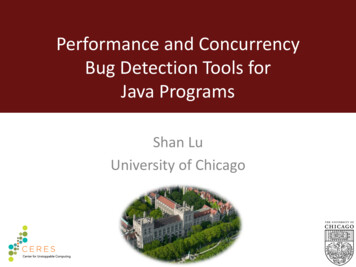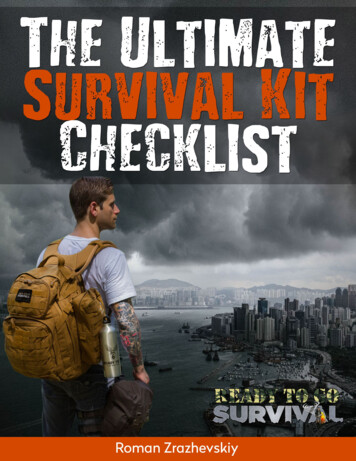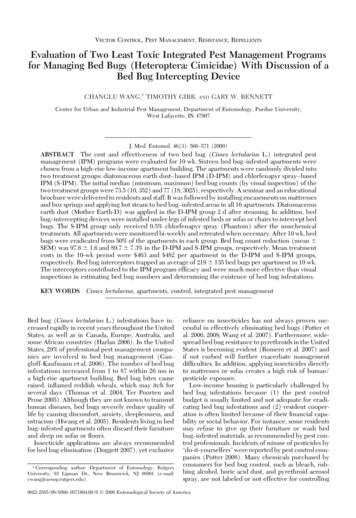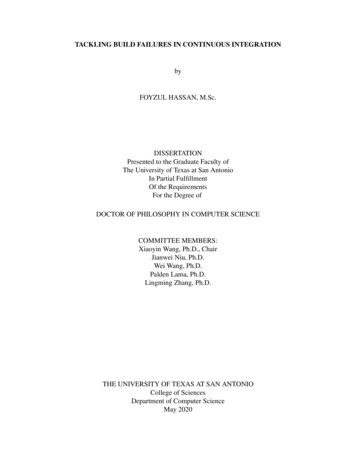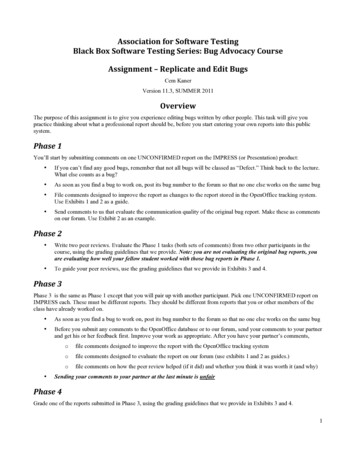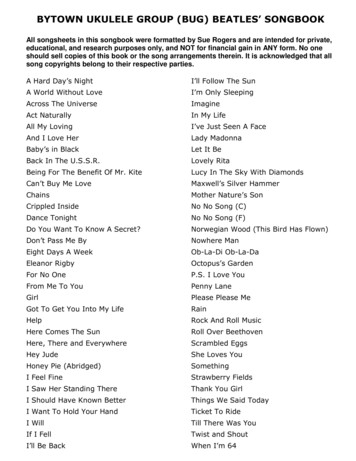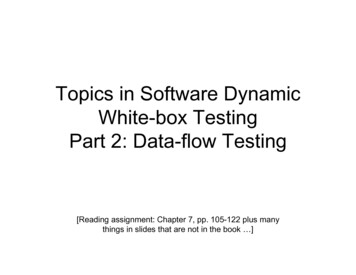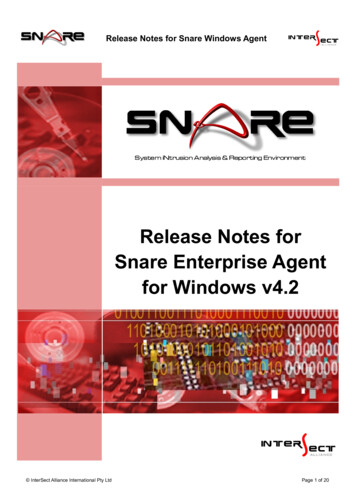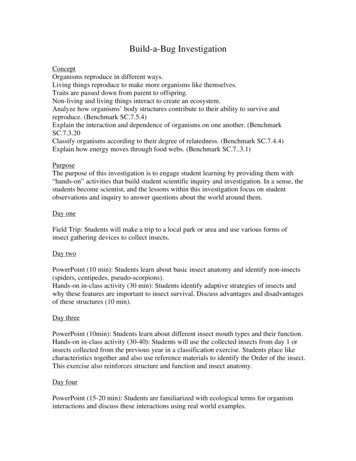
Transcription
Build-a-Bug InvestigationConceptOrganisms reproduce in different ways.Living things reproduce to make more organisms like themselves.Traits are passed down from parent to offspring.Non-living and living things interact to create an ecosystem.Analyze how organisms’ body structures contribute to their ability to survive andreproduce. (Benchmark SC.7.5.4)Explain the interaction and dependence of organisms on one another. (BenchmarkSC.7.3.20Classify organisms according to their degree of relatedness. (Benchmark SC.7.4.4)Explain how energy moves through food webs. (Benchmark SC.7.3.1)PurposeThe purpose of this investigation is to engage student learning by providing them with“hands-on” activities that build student scientific inquiry and investigation. In a sense, thestudents become scientist, and the lessons within this investigation focus on studentobservations and inquiry to answer questions about the world around them.Day oneField Trip: Students will make a trip to a local park or area and use various forms ofinsect gathering devices to collect insects.Day twoPowerPoint (10 min): Students learn about basic insect anatomy and identify non-insects(spiders, centipedes, pseudo-scorpions).Hands-on in-class activity (30 min): Students identify adaptive strategies of insects andwhy these features are important to insect survival. Discuss advantages and disadvantagesof these structures (10 min).Day threePowerPoint (10min): Students learn about different insect mouth types and their function.Hands-on in-class activity (30-40): Students will use the collected insects from day 1 orinsects collected from the previous year in a classification exercise. Students place likecharacteristics together and also use reference materials to identify the Order of the insect.This exercise also reinforces structure and function and insect anatomy.Day fourPowerPoint (15-20 min): Students are familiarized with ecological terms for organisminteractions and discuss these interactions using real world examples.
Introduce Build-a-Bug Project: Begin to develop ideas and discussion about potentialinsect structures and functions. Students work on an in-class worksheet (20-30 min) onniche and niche description, abiotic and biotic factors, and initial drawing of insect.Day fivePowerPoint (10-15 min): Introduce students to incomplete and complete metamorphosisof insects.Introduce the building materials and expectations.Day six and sevenAllow students to work on their project: They should decide on a life cycle, develop atleast two ecological interactions, and identify abiotic and biotic factors.Day eightPresentations of individual or joint projects.
Background for Insect InvestigationInsectsInsects are found everywhere on terrestrial Earth except for the coldest polar regions ofthe North and South Pole. Insects are by far the most numerous, most diverse, and couldbe viewed as the most ecologically important terrestrial creatures on the planet. They canbe found in your home, under the ground, on vegetation, under water, and are even foundthousands of feet in the air.The key ecological functions they provide range from, providing a food source for many,decomposers and recyclers of organic materials, plant pollinators, and produce importantproducts like honey and silk. Humans see insects as both beneficial and detrimental.Insects cause worldwide damage to crops (cotton, corn), livestock (cattle), and arevectors for disease (malaraia). However, insects are also used to reduce invasive or pestspecies (biological control), solve crimes (forensics), and used extensively in scientificresearch (genetics).The number of insects worldwide surpasses the total number of species of plants andother animals combined. Over one million insects have been identified worldwide and thenumber keeps increasing. Seventy two percent of all animals are insects. It is unknownwhat the total number of insect is and how many different types of them there are. Somecolonies of insects have populations in the millions.Anatomy & Life CycleKey features that distinguish insects include a hard outer layer called an exoskeleton,three body regions (head, thorax, and abdomen), two antennae, and six jointed legs.Insects have different stages of development and molt (shed outer exoskeleton) as theygrow, sometimes the immature forms called nymphs may resemble the adult. This iscalled incomplete metamorphosis. If the juvenile stage is completely distinct inappearance (larvae) and habits it is called complete metamorphosis. This life cycle alsoincludes a pupae or cocoon stage.Insects have passive respiration which takes air into the body through a series of tubescalled tracheae. Insects do not have blood rather it is called hemolymph.All insects have three main body regions: the head, the thorax, and the abdomen.The HeadThe head is the first body part of an insect and the main parts on the head are the eyes(simple and compound), two antennae, and the mouthparts.The ThoraxThe thorax is the second body part or the middle section of the insect. The wings andlegs are connected to this portion. The thorax is covered by a pronotum and is dividedinto three segments, the prothorax, metathorax, and mesothorax. Each segment has apair of legs and the metathorax and mesothorax have wings on the top of the insect.
The pronotums shape and features are sometimes used to identify insects.The legs of different insects are adapted to do different things. The legs of some insectsare adapted for swimming, burrowing, jumping, or grasping.The wings (if present) come in various shapes and design.The AbdomenThe abdomen contains the digestive and reproductive organs. The main structures on theabdomen include the spiracles, ovipositor, and prolegs (larvae only, found oncaterpillars and some sawflies). The abdomen spiracles are tiny openings for passivebreathing. The ovipositor is used for egg laying by females. On some insects, there is alarge round disc on the first called a tympanum and is the insect’s ear.Image fromhttp://www.sidney.ars.usda.gov/grasshopper/ID Tools/F Guide/images/fig1.jpgClassificationUnderstanding the taxonomic classification of any organism is important foridentification. Students can draw connections when classifiying insect Order and Family,because these divisions can be used to link insect structure and function and they sharesimilar characteristics. The levels of classification are:Kingdom: AnimaliaPhylum: Arthropoda – these include the arthropods, also with exoskeletons and jointedfeet. (insects, spiders, crabs, among others)Class: Insecta – Three body parts (head, thorax, abdomen), six legs, two antennae.Order: the number of Orders varies depending on what you reference. However,somewhere around 30 Orders have been identified. Among the most recognized areHemiptera (true bugs), Coleoptera (beetles), Lepidoptera (butterflies and moths), Diptera(flies), Hymenoptera (ants, bees, and wasps), Orthoptera (grasshoppers and crickets) andOdonata (dragonflies).
Family: An important level of insects where entomologists further group insects bystructure and function. For example, the hawk moths belong to the Order Lepidoptera,Family Sphingidae.Genus: a further classification level where very similar characteristics are identifiedSpecies: a reproductively distinct groupScientific Name (binomial nomenclature): Genus and speciesThe scientific name for a species is either in Latin or Greek and is two part. It is auniversal way of describing organisms to avoid misunderstandings which can arise whenusing the common name of a species.Example: Tyrannosaurus rex, translated into English tyrant (tyrannos) lizard (saurus)king (rex).
NameDateTell me what you know about insectsWhat is an Insect? (Think about body parts and features)How many different kinds of insects are there in the world? Hundreds? Thousands?Millions?Why are insects important? What kind of “jobs” do they have?Where do insects live? (Name all the places you can find insects)How do insects grow?Are insects good? Bad? Or Both?What is endemic? Native? and Introduced?What would the world be like without Insects?What kind of strategies do insects use to survive and thrive? (think about insectstructures or interactions)What do you want to know about insects?
Assessment of observationsCan you answer some of these questions from observing this insect?How does it grow? YesorNoWhere is it found? Yes orNoWhat does it eat or who eats it? YesWhere did it come from? ? YesororNoNoWhat kind of lifecycle does it have? YesorNoHow does it reproduce? How many generations are there in a year? YesHow long do they live? YesIs it a pest or beneficial? YesororNoNoIs it endangered or threatened? YesDo humans affect this organism? YesorNoorNoWhat was the most interesting thing you learned about your insect?orNo
Build-a-Bug InvestigationDay 1Insect Collection/Bug HuntConceptAnalyze how organisms’ body structures contribute to their ability to survive andreproduce. (Benchmark SC.7.5.4)Classify organisms according to their degree of relatedness. (Benchmark SC.7.4.4)OverviewThis is an outdoor activity that allows students to investigate there surrounding andproblem solve ways to capture insects. Students should be dressed appropriately for theoutdoors. Ideally the field trip should take place in a park where there is a body of waterand lots of vegetation. This will increase the likelihood of gathering insects as well asallow students to see variation in habitat occupied by insects.Note: This exercise can be supplemented by students capturing insects athome or at school prior to the field trip. This may be necessary toaccumulate the needed amount of insects for the classification exercise.Consider extra credit for those who participate.PurposeThe insects collected will be used in subsequent lessons where they will investigatestructure and function as well as taxonomic classification.Materials Insect nets (fine mesh fishing nets can be used as a substitute) Images at end oflesson Killing Jar (Large glass jar with cover, may need more than one). Place alcoholsoaked cotton balls in the bottom along with crumpled pieces of tissue paper forinsects to hide in. Leave insects overnight. Label the jar to identify it as noxious. Tupperware containers or any covered container to hold insects before going intokilling jar. Umbrella, preferably white of light colored. (Turn is upside down and it can beused under trees or shrubs that are shaken or beaten, catches falling insects) Aspirators (can be constructed out of old film canisters, nylon, and rubber tubingor flex straws) Image at end of lesson Hand troll or small rake (to move loose piles of dirt or gravel) Small fish nets (for water insect capture) Tweezers or forceps to grab insects.Background Information/PreparationThe collection of insects should be conducted well in advance of the field trip. This willhelp students get proficient at catching insects as well as met the necessary number ofinsect samples needed for subsequent lessons. Instruct your students to be motivated andencourage them to collect insects at home or at school. Insects collected in advance1
should be placed in the freezer. Bait traps, light traps, and pitfall traps (Diagram at end oflesson) could be placed ahead of time in designated areas. Light traps are just a catchmentcontainer under any outdoor light. Bait traps are design like pitfall traps with the additionof meat, fruit, peanut butter, or sugar in them. Each will attract different insects.MotivationCome on! It’s an outdoor activity!SafetyNo inappropriate behavior (tackling, pushing, etc.). Running may be required butstudents should be reminded to be aware of their surroundings. Insects do bite and sting!Therefore, students with allergies to insects and their kin (bees, centipedes, andspiders) should be identified and precautionary measures should be taken. Studentsshould avoid these critters!Activity1. Very simple, catch some insects and place them in the container. Students shouldform small groups and target different areas for collections. Ensure students haveequal time catching insects.Note: Instruct students to capture insects on sight or by running the netthrough vegetation where insects may be more cryptic and camouflaged.Also, disturbing the ground or around plants may flush insects from theirhiding place.2. Collect all the insects in a large container or bag and place them in the freezer forpreservation.Note: Proper pinning of winged insects like butterflies and moths, maynot be done if insects are place in the freezer first.3. Pinning insects could also be untaken.Going further/ExtensionStudents should be encouraged to discuss the different levels of difficulty in capturinginsects and draw some conclusions as to why that is. Are flying insects easy to capture?Where some of the insects hard to see?Also, students can discuss where certain insects where captured. In the air, on a plant,under the ground, over water, and discuss a possible link between structure andenvironment.Students could have a competition to determine which technique catches the most insectsor what bait is best.Concept DiscoveryIdentify insects from non-insects. Design a method of capturing insects.AssessmentStudents will be assessed by active participation and responsible behavior.2
http://www.byteland.org/bioluminus/mouth ology.wisc.edu/mbcn/pitfall.jpg3
Aquarium fish nets www.online-garden-centre.comInsect nets http://www.roseentomology.com/Insect Nets.htm4
Build-a-Bug InvestigationDay 2Introduction to Key Features of Insects/What do I do?ConceptAnalyze how organisms’ body structures contribute to their ability to survive andreproduce. (Benchmark SC.7.5.4)OverviewThe students will be introduced to key features of insects and attain a basic knowledge ofinsect body form. Students will also be able to identify insects from non insects (spiders,centipedes). Students will also understand that insect body forms develop under differentstrategies, which enhance their ability to reproduce and survive. Furthermore, studentswill compare and contrast individuals and place them in “like” groups based on similarcharacteristics and structure. Student will specify the reasons for classification based ontheir observations and discuss their results with other groups.PurposeTo have students identify adaptive strategies of insects and why these features areimportant to insect survival.Materials Five sets of insect images that demonstrate camouflage, defense, warningcoloration, burrowers, flyers, and aquatic insects Include classification cards for organization (Camouflage, Flying, etc.)Background Information/ PreparationTeacher will begin the class by introducing the common features of insects anddistinguish non-insects (spiders and centipedes). Insects have two antennae, six legs(three on each side of thorax), and three body parts (head, thorax, and abdomen). Teacherwill need to become familiar with each insect card and know the particular features of theinsect.MotivationIn everyday life we often times change our appearance/structure in order to accomplishsome task. The change in appearance/structure allows us to gain an advantage in what wewant to accomplish. If we are going hunting, we were camouflage or bright colors toconceal ourselves or warn others of our presence. Also, think of the medieval knights ofold who wore armor to protect themselves. The armor serves as protection, but limitsmobility. Organisms have evolved different strategies to enhance their survival. Insectsprovide an excellent example.SafetyNo eating insect images
Activity1.Pass out a collection of images to each group of students and have them makeobservations. Next, have them begin to group insect that they think share the samestrategies. Walk around the room to monitor and ask questions to help those havingtrouble making observations. Also ask students why they have chosen their group ofinsects. Allow students to classify the structures on their own first, beforeintroducing the category cards. The exercise may work better for a classroom ofadvanced students that may not need as much guidance and the category cardssupplement their findings.Note: No Right Answer, some of the students may get hung up on gettingthe right answer rather than using their own observations to do that. Iencourage the students to choose their own categories but challenge themto explain why they chose the way they did.2.Once they have determined their insect groups. Students will share their decision toeach other and discuss the characteristics they have in common. Important tomention that: insects may be in more than one group. The student’s discussion as towhy they have chosen to place something in a particular group may need to befacilitated by the teacher who may also have to redirect or guide misconceptions orerrors in structure and function.Going further/ExtensionHave students write down a reflection in their journal about what they learned. Forexample, I learned that insects with bright colors might be poisonous or distasteful topredators. Insects that burrow have short powerful legs. Another extension would be torecord the advantages and disadvantages of each structure. You could also expandstructure to other organisms. For example, Dragonflies are primarily flyers, what otherorganisms are primarily flyers? Birds and Bats.Concept DiscoveryStudents will use their own observations about their insect characteristics to group theminto adapted strategies for survival.
Insect camouflageInsect Warning Colors
Burrowing InsectsDefensive InsectsLarge antennae
Aquatic insects
Flying insects
Membracid, fulgorid, peanut head, shield bugAnt mimic, thorn mimic,
CamouflageAquaticFlyersBurrowersWarning ColorsDefensiveLong AntennaeArmored
MimicStructureAdvantagesDefensiveProtection frompredatorsArmoredAquaticGood ProtectionGood swimmers,evade terrestrialpredatorsFast, easy escapefrom predators,move to preyHide frompredators or preyEscape predatorsLets predatorsknow you arepoisonous or sadvantagesLoss ofmobility,expensiveSlow movingRestricted towater, habitatlossFragile, lessprotectionLimited tocertain habitatSlowEasy to see
INSECT ANATOMYLily EdmonWaimea Middle SchoolSteve SouderGK-12 PRISM Fellow
The common features of all Insects include:Three body parts: Head, Thorax, and AbdomenSix LegsTwo AntennaeTwo Eyes (simple or r/ID Tools/F Guide/images/fig1.jpg
ages/29.jpg
8/2.htm
Non-InsectCentipede entipede anatomy.html
Am I an iders/text/Myrmarachne typical/animals/centipede from apetlanca jpg.html
Am I an g
One more .com/jamato8/image/60592124
Insect body partsFlyGrasshopper
orner.co.uk/insects/centipedes/centipede anatomy.html
Build-a-Bug InvestigationDay 3Have you seen my “Family”? Version 1 w/o insectsInsect Classification Version 2 with insectsConceptStructures of organisms provide a function which allows them to survive and reproduce.Organisms are classified in a hierarchal system.OverviewThe students will identify characteristics of insects, which enhance their ability toreproduce and survive. Furthermore, students will compare and contrast individuals andplace them in categories based on similar characteristics and structure. Student willspecify the reasons for classification based on their observations and discuss their resultswith other groups.PurposeTo have students identify what characteristics can help classify insects and why thesefeatures are important to insect survival.Materials (Version 1) Five sheets of chart paper or five boards. One copy of each insect image (provided at end of lesson) Copy of written clues (for teacher) Science journal (if none, just use plain paper) Copy of Insect Key (for teacher) Family labels (provided at end of lesson) 6 folders Insect field guides and books (recommended)Materials (Version 2) Five 12 x 12 x inch Styrofoam pieces for insect placement Collection of insect specimens from day 1 (preferably pinned insects) Tweezers or forceps (Only if non-pinned specimens) Receptacles to hold insects Labels of insect orders (provided at end of lesson) Magnifying glasses Insect field guides and books (recommended)Background Information/PreparationVersion 1.Teacher will need to become familiar with each insect image and need to know thefamily and common name. Write clues onto the chart paper or write on board. Cover the
clues somehow so students cannot see it until the exercise begins. Write the name ofeach insect family on a folder.Version 2.Organize the insects collected from day 1 into their Orders using field guide or insectbook. Distribute the insects evenly into five groups trying to have a representative foreach Order in every observing group. Insect should be pinned if teacher is familiar withthe technique to help preserve the specimens. Familiarize yourself with the Linnaeanclassification system.MotivationVersion 1.A hurricane or any other natural disaster has displaced insect relative around theclassroom. In order to restore order each insect must locate its family members. How dowe get them back together?Version 2.Begin to pose questions about how students can classify themselves. Are theresimilarities and differences between them? How could you start to divide into smaller andsmaller groups until you have an individual identified?For example, 1. boys and girls, 2. boys short boys tall, 3. tall boy with brown hair, 4.tallboys with brown hair and blue eyes, 5. tallboy with brown hair and blue eyes withglasses, etc SafetyNo running, horseplay, and please be patient.Insect pins are extremely sharp and care should be taken when handling them. Only theball of the pin should be handled.ActivityVersion 11. Pass out an image to every student and instruct him or her to keep the image tothemselves. Have them make observations and write down three distinguishingcharacteristics about their insect. Walk around the room to monitor and askquestions to help those having trouble making observations.2. Once they have written the information down, uncover the clues. Instruct thestudents that they will need to read the clues to find their insect family. Once theyfind their family name, they will need to find the folder with that name on thedesks and go sit by it. Students will then get up and walk around, following theclues.3. While students are walking around set up the family cards at the tables. Once allmembers are together, students will reveal their insects to each other and discussthe characteristics of their family out loud.
Version 21. Form your class into five groups. Pass out the Styrofoam pieces and reveal theinsect specimens. Each group will work together to classify insects into differentOrders. Have reference materials available.Note: It is a good idea to review the basic features of an insect (three bodyparts: head, thorax, and abdomen, two antennae, and six legs all attachedto the thorax) and challenge students to identify anything that is not aninsect. This will make the build-a-bug portion go smoother and addressmisconceptions students have when they begin building their insects.2. Begin the exercise by telling students that they are going to be “scientist” and aregoing to classify the insects by similar structures and characteristics. They shouldbe advised to also think about the structure and functions that they observe. Also,have them be prepared to discuss what type of food the organism may eat basedon the mouth structure.3. Pass out the Order labels at a time when students are either having difficultymaking decisions or when they feel their classification is complete. This willreinforce what they should have already established or help guide them in theright direction.4. Once all groups have completed their classification, engage each group to discussa particular Order with the rest of the class and have them identify adistinguishing feature and its possible function. Also, have them discuss thepotential food source based on the mouth structure. Teacher may have to facilitatethis portion.5.Going further/ExtensionVersion 1.Redistribute cards and have students try again.Version 2.Every student should be familiar with grasshoppers and butterflies. Ask students if theyknow how these two organisms develop and use these to examples to introduce studentsto the life cycles of insects which will be covered on day 4. For example, Lepidoptera:complete metamorphosis, egg, caterpillar, cocoon, butterfly or moth. Orthoptera:incomplete metamorphosis, egg, nymph, adult.Concept DiscoveryStudents will use their own observations about their insect characteristics to group theminto Families or Orders. Also, they will be able to discuss these characteristics that helpthem survive.Version 1.CluesBoard 1:I have triangle shaped wings: go to board 2I don’t have wings: go to board 5I look hard and shiny: go to board 3
I have very long back legs: go to board 4I have four unfolded wings with spots near the tips: go to board 5I have a large triangular head: go to board 4Board 2:I have wings that look like a leaf: go to Family Tettigoniidae 4I look soft and fuzzy: go to board 3I have a triangle shape in the middle of my back: go to Family CetoniidaeBoard 3:I have pincers at the tip of my abdomen: go to Family LabiduridaeI have a short thick abdomen that can be seen: go to Family SphingidaeI have bright colors: got to board 2Board 4:I have 2 large eyes: go to board 5I have very long antennae: go to board 2I have a long narrow abdomen that is not covered by my wings: go to Family LibellulidaeBoard 5:I have large folded front legs: go to Family MantidaeI have large compound eyes that give my head a round shape: go to board 4I have short stout legs and thick abdomen: go to board 3Insect CetoniidaeTettigoniidaeFulgoridaeCommon NamesHawk MothsDragonfliesCommon Praying MantidsStriped EarwigsFlower ChafersKatydidsPlanthoppers
Sphingidae/Oleander hawk moth, Small elephant hawk moth, Lime Hawk moth
Cetoniidae/Tropical rose chafer, Red chafer beetle, Dicronorhinna derbyana
Tettogoniidae/Leaf Katydids
Mantidae/ praying mantis adult.
Libellulidae DragonflyLabiduridae/Striped earwigs
SphingidaeLibellulidaeMantidae
LabiduridaeCetoniidaeTettigoniidaeFulgoridae
Version 2.DipteraOdonataLepidopteraHemiptera
HymenopteraColeopteraOrthoptera
Insect Mouth TypesSteve SouderFellow PRISM GK-12
Chewing Mouth PartsUsually found oninsects that arepredators,aggressive, or feedon vegetation.Mouth parts seenhere are called .htm
Sucking Mouth PartsThe slender, tubularfeeding and suckingorgan of certaininsects.True bugs use theirmouthparts to extractfluids from plants andanimals. Butterfliesuse it to extract nectarfrom flowers.http://www.backyardnature.net/insmouth.htm
Sucking Mouth PartsThe labium seen here isused to suck up fluids likea sponge.Most insects with thismouth part do not chewor bite, instead they vomitdigestive enzymes onthere food in order to lapit up.Don’t let flies touch m
Combination Mouth PartsThese insects have acombination of mouthparts that enable them tosurvive and thrive.The carpenter bee seenhere has both chewingparts (galea) to borethrough wood and aglossa that acts like atongue to ingest nectarfrom flowers.http://www.backyardnature.net/insmouth.htm
DipteraOdonataLepidopteraHemiptera
HymenopteraColeopteraOrthoptera
Insect Mouth StructuresImages from www.backyardnature.netInsect mouth Types from left to right top to bottom: OrderDiptera Sucking (sponge like), Order Hymenoptera Chewing(two large mandibles), Order Hemiptera Sucking (Proboscis),Order Lepidoptera Sucking (Proboscis), Order Hymenopterachewing and sucking, Order Coleoptera chewing (cuttingvegetation).Insect mouth parts come in a variety of form and have often been generalized as either a"sucker" or a "chewer."One type called a proboscis is a tube like structure that can either be folded back orrolled up. Butterflies suck nectar out of flowers with a rolled up proboscis, assassin bugsused a folded back proboscis to suck nutrients out of prey.MOUTHPARTS OF SELECTED INSECT ORDERSOdonata (dragonflies): chewingHemiptera (true bugs): suckingColeoptera (beetles): chewingLepidoptera (butterflies & moths): suckingDiptera (flies): suckingHymenoptera (wasps, bees): chewing, chewing-suckingOrthoptera (grasshoppers & crickets) chewing
Build-a-Bug InvestigationDay 4-8Building the BugConceptOrganisms reproduce in different ways.Living things reproduce to make more organisms like themselves.Traits are passed down from parent to offspring.Non-living and living things interact to create an ecosystem.Analyze how organisms’ body structures contribute to their ability to survive andreproduce. (Benchmark SC.7.5.4)Explain the interaction and dependence of organism
Build-a-Bug Investigation Concept Organisms reproduce in different ways. Living things reproduce to make more organisms like themselves. Traits are passed down from parent to offspring. Non-living and living things interact to create an ecosystem. Analyze how organisms' body structures contribute to their ability to survive and reproduce.
